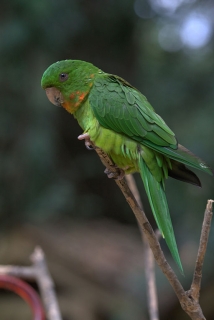Red-throated Conure |
|
|
Also known as: Red-throated Parakeet, Orange-throated Conure
Photos
View in GalleryDid You Know?
The red throat of this species distinguishes it from all of the other green Psittacara sp. conures.Academic Research
Related publications: Psittacara rubritorquisSpecies Profile
Genus: Psittacara | Species: rubritorquis
Size:
28cm (11 in)
Weight:
130g (4.5 oz)
Subspecies including nominate:
one
Colour Adult:
Both adults in general green, with yellow on underparts; orange/red throat and foreneck, with scattered orange/yellow feathers; varying orange/red feathers scattered on lower cheeks and sides of neck; blue tinge to primary coverts and outer webs of flight feathers; yellow/green underwing coverts; dull yellow undersides of flight feathers. Bill horn in colour. Eye ring bare and brown/grey. Eye orange.
Colour Juvenile:
Red on throat, cheeks and sides of neck minimal or absent. Eye brown.
Call:
Calls described as more high-pitched than Pacific Conure; in flight a loud, screaming noise. When perched emits more varied and persistent notes.
Listen NowMore Information:
Content Sources:
CITES
BirdLife International
Cornell Lab of Ornithology/Birds of the World
A Guide to Parrots of the World, Juniper and Parr, 1998
xeno-canto Red-throated Parakeet, Cooper, Jacob C. XC327734
Parrots of the World, Forshaw and Cooper, 1977.
Parrots of the World, Forshaw, 2006.
Parrots in Aviculture, Low, 1992.
Lexicon of Parrots, Thomas Arndt.
AvianWeb
Photos
View in GalleryDid You Know?
The red throat of this species distinguishes it from all of the other green Psittacara sp. conures.Academic Research
Related publications: Psittacara rubritorquisSpecies Care
Captive Status:
Rare
Longevity:
Up to 35 yrs
Housing:
Aviary or suspended enclosure, metal construction, 2-3m (6.5-9.8 ft).
Diet:
Fruits such as: apple, pear, banana, orange, pomegranate, cactus fruits, forming about 30 percent of diet; vegetables such as: carrot, celery, green beans, peas in the pod; fresh corn; green leaves such as: Swiss chard, lettuce, dandelion, chickweed, sowthistle; spray millet; small seed mix such as: canary, millet, and smaller amounts of oats, buckwheat, safflower and a little hemp; soaked and sprouted sunflower seed; cooked beans and pulses, boiled maize, and complete pellet.
Enrichment:
Socialization, bathing. Vigorous chewer, so provide bird-safe branches of pine, willow, elder and fir, heat sterilized pine cones, vegetable tanned leather chew toys. Also provide swings, ladders, different sized perches and foraging/puzzle toys.
Nest Box Size:
Vertical box 10" x 10" x 20" (25.4cm x 25.4cm x 50.8cm).
Clutch Size:
3-4
Incubation Time:
24-25 days
Fledging Age:
8 weeks
Hatch Weight:
Not recorded.
Peak Weight:
Not recorded.
Weaning Weight:
Not recorded.
Photos
View in GalleryDid You Know?
The red throat of this species distinguishes it from all of the other green Psittacara sp. conures.Academic Research
Related publications: Psittacara rubritorquisSpecies Wild Status
World Population:
Unknown, stable.
IUCN Red List Status:
Least Concern
CITES Listing:
Appendix II
Threat Summary:
Overall decline has occurred due to conversion of forest to agriculture.
Range:
Central highlands and nearby Pacific slope of E Guatamala to W Nicaragua.
Habitat:
Found from 600-1800m (1968-5904 ft) in various kinds of wooded areas except tropical rainforest. In both moist and scrubby open woodland and farmland in Guatamala and in Pinus sp. forest in Nicaragua.
Wild Diet:
Feeds on seeds of Mimosa, fruits of Myrica mexicana, Ehretia anacua, Ceitis laevigata, Washingtonia and Melia azedarach. Also takes Populus buds and Quercus acorns. May also take seed and maize crops.
Ecology and Behaviour:
Found in flocks when not breeding, pairs during season. Larger congregations occur where food is plentiful. Nesting occurs in tree cavities, rock crevices, holes in buildings or termite mounds.
Clutch and Egg Size:
3-4 rounded eggs, 30.0 x 24.5mm (1.2 x 0.9 in).
Breeding Season:
August in Guatemala. Nest is likely in tree cavity.
Photos
View in GalleryDid You Know?
The red throat of this species distinguishes it from all of the other green Psittacara sp. conures.Academic Research
Related publications: Psittacara rubritorquisMembers Only Resources
Please log-in now to find more research, resources and tools.
Not a Member?
Find more great information:
Gain exclusive access to 600+ pages of additional research, seminars and podcasts, specialists to ask your toughest questions, and dozens of other fun resources - when you become a WPT member.
Join Today >>

































